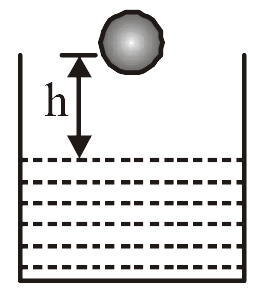A soild ball of density half that of water falls freely under gravity from a height of 19.6 m and then enters water. Upto what depth will the ball go. How much time will it take to come again to the water surface? Neglect air resistandce and viscosity effects in water. (Take g=9.8m/S2).
Suppose m is mass of the ball and ρ is density of the ball. Therefore, density of water =2ρ.
As the ball falls from a height of 19.6m, therefore, energy of the ball on striking the water surface =mgh=mg×19.6J.
Net force opposing the motion of the ball in water.
= upthrust - wight of ball
=mρ×2ρ×g−mg=mgN
If d is depth upto which the ball goes in water, then
work done = energy of the ball
mg×d=mg×19.6∴d=19.6m
Velocity on striking the water surface
v=√2gh=√2×9.8×19.6=19.6m/s
If t is time taken by the ball to travel a depth (d) in waer, then from
v=u+at
0=19.6−(9.8)t,t=19.69.8=2s
Total time taken by the ball to come again to the water surface =2+2=4s.
Topper's Solved these Questions
- BOOK - PRADEEPCHAPTER - WORK, ENERGY AND POWEREXERCISE - NCERT EXERCISES WITH SOLUTIONS30videos
WORK, ENERGY AND POWER
- BOOK - PRADEEPCHAPTER - WORK, ENERGY AND POWEREXERCISE - Additional Exercises3videos
WORK, ENERGY AND POWER
- BOOK - PRADEEPCHAPTER - WORK, ENERGY AND POWEREXERCISE - Long Answer Question24videos
WORK, ENERGY AND POWER
- BOOK - PRADEEPCHAPTER - THERMODYNAMICSEXERCISE - Assertion- Reason Type Questions19videos
THERMODYNAMICS
Similar Questions
A solid ball of density half that of water falls freely under gravity from a height of 20m and then enters water. Up to what depth will the ball go ? How much time will it take to come again to the wate surface ? Neglect air resistance and viscosity effect in water.
View SolutionA solid ball of density half that of water falls freely under gravity from a height of 19.6 m and then enters water. Upto what depth will the ball go? How much time will take to come again to the water surface? Neglect air resistance and viscosity effects in water (g=9.8m/s2)
View Solution
Knowledge Check
- Question 1 - Select One
A solid ball of density half that of water falls freely under gravity from a height of 19.6 m and then enters water. Neglecting air resistance and viscosity effect in water, the depth up to which the ball will go is (g=9.8m/s2)
A19.6 mB9.8 mC14.7 mD12.7 m - Question 2 - Select One
A ball is dropped from a building. Height of the building is 45 m. The ball moves under the effect of gravity.
How much time will it take to reach the ground?A3sB6sC5sDnone - Question 3 - Select One
A ball whose density is 0.4×103kg/m3 falls into water from a height of 9 cm. To what depth does the ball sink ?
A9 cmB6 cmC4.5 cmD2.25 cm
Consider a ball of density 0.5×103kg/m3 falling freely into the water from a height of 10 cm. Now, find the depth (in centimetres) to which the ball will sink:
View SolutionA metal ball of mass 5 kg falls from a height of 490 m. How much time will it take to reach the ground ?
View SolutionA wooden ball of density D is immersed in water of density d to a depth h//2 below the surface of water and then relased. To what height will the ball jump out of water ?
View SolutionA ball of relative density 0.8 falls into water from a height of 2 m. find the depth to which the ball will sink (neglect viscous forces)
View SolutionA ball of radius r and density r falls freely under gravity through a distance h before entering water. Velocity of ball does not change even on entering water. If viscosity of water is η the value of h is given by
 View Solution
View Solution

